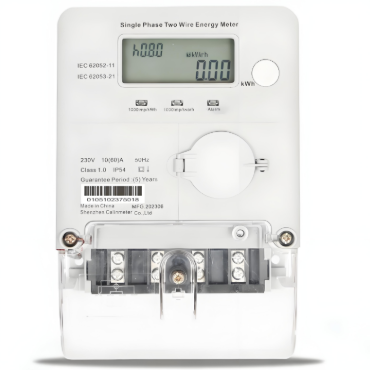
Overview
With the deep integration of energy transition and the digital economy, traditional electricity management models can no longer meet the demands for precision, intelligence, and low-carbon development. This solution leverages advanced smart meters and IoT technologies to build a smart electricity management system covering various scenarios such as residential, commercial and industrial, distributed energy, and electric vehicle charging. It aims to improve energy efficiency, ensure safety, reduce costs, and promote the integration of renewable energy.
I. Residential Smart Electricity Management
Application Scenarios: Homes, apartments, communities
Core Solutions:
- Real-Time Electricity Monitoring and Data Analysis
- Function: High-precision smart meters collect real-time electricity data for total household consumption and individual circuits.
- Implementation: Users can easily access daily, weekly, and monthly electricity consumption charts and historical records via mobile apps or web portals, gaining insights into usage habits and fostering energy-saving awareness.
- Smart Time-of-Use Billing and Electricity Cost Optimization
- Function: Automatically identifies peak, off-peak, and standard pricing periods.
- Implementation: The system sends usage suggestions to users, guiding them to operate high-consumption devices (e.g., washing machines, water heaters) during low-price periods, effectively shifting usage away from peak times and directly reducing electricity costs.
- Proactive Electricity Safety Alerts
- Function: Monitors abnormal currents and voltage fluctuations in circuits in real time.
- Implementation: Upon detecting potential hazards such as leakage, short circuits, or overloads, the system immediately sends alerts to users via app notifications or SMS, significantly enhancing household electricity safety.
- Integration with Smart Home Systems
- Function: Seamlessly integrates with smart home platforms (e.g., Mi Home, HomeKit) through open APIs.
- Implementation: Automatically optimizes the operation schedules and power levels of high-consumption devices (e.g., air conditioners, water heaters, EV charging piles) based on real-time electricity prices or preset scenarios, achieving an optimal balance between energy efficiency and comfort.
II. Commercial and Industrial Energy Efficiency Optimization
Application Scenarios: Factories, shopping malls, office buildings, data centers
Core Solutions:
- Multi-Circuit Precision Metering
- Function: Supports independent and synchronized monitoring of multiple power circuits (e.g., production lines, departments, floors, server rooms).
- Implementation: Enables refined energy management and cost allocation, providing accurate data for internal assessments and energy audits.
- Load Forecasting and Demand Management
- Function: Predicts short-term electricity load trends based on historical data and AI algorithms.
- Implementation: The system provides early warnings for transformer overload risks and automatically or advises managers to adjust controllable loads (e.g., central air conditioning, lighting systems), smoothing the electricity consumption curve and avoiding high capacity charges due to peak demand.
- In-Depth Power Quality Analysis
- Function: Continuously monitors power quality parameters such as harmonics, voltage sags/swells, and power factor.
- Implementation: Identifies power quality issues in a timely manner, assesses their impact on sensitive equipment, and provides decision-making support for mitigation measures (e.g., installing filters, reactive power compensation), extending equipment lifespan and reducing production downtime risks.
- Automated Energy Efficiency Reports and Diagnostics
- Function: The platform automatically generates multi-dimensional energy efficiency reports (daily, monthly, annual).
- Implementation: Reports not only display electricity data but also provide concrete energy-saving recommendations, such as identifying inefficient motors, suggesting LED lighting replacements, and optimizing ventilation system operations, continuously uncovering energy-saving potential.
III. Distributed Energy Integration
Application Scenarios: Residential/commercial & industrial PV systems, energy storage systems, park-level microgrids
Core Solutions:
- Bi-Directional Power Precision Metering
- Function: Supports bi-directional metering, accurately recording self-consumed PV generation, electricity fed into the grid, and electricity drawn from the grid.
- Implementation: Provides accurate settlement basis for the "self-consumption, surplus feed-in" model and clearly demonstrates the benefits of distributed energy.
- Dynamic Electricity Price Response Strategy
- Function: Interfaces with grid electricity price signals (e.g., real-time pricing).
- Implementation: Intelligently controls the charging and discharging timing of energy storage systems based on price fluctuations: charging during low-price periods and discharging during high-price or peak demand periods, maximizing self-consumption and reducing electricity costs.
- Virtual Power Plant (VPP) Aggregation and Integration
- Function: Aggregates distributed energy resources, energy storage systems, and controllable loads into a unified entity.
- Implementation: Responds to grid dispatch commands, participates in market transactions such as demand response and peak-shaving ancillary services, and generates additional revenue from green energy while ensuring user electricity needs are met.
IV. Electric Vehicle Charging Management
Application Scenarios: Public charging stations, shopping mall charging piles, residential private/shared charging piles, battery swap stations
Core Solutions:
- Dedicated Identification and Time-of-Use Billing
- Function: Intelligently identifies charging pile circuit electricity consumption and separates it from general office or residential usage.
- Implementation: Supports independent pricing strategies for charging services (e.g., time-of-use pricing), enabling precise billing and flexible operational models (e.g., external service offerings).
- Smart Load Balancing Control
- Function: Monitors the total load of the charging site in real time.
- Implementation: When multiple charging piles operating at high power risk overloading the local transformer, the system automatically and intelligently schedules, dynamically allocates, or limits the output power of each charging pile to ensure grid safety and stability.
- Green Charging and User Experience Optimization
- Function: Interfaces with vehicle networking platforms and energy management platforms.
- Implementation: Allows users to schedule charging times via app (e.g., setting charging to start during off-peak hours) and prioritizes the use of on-site photovoltaic green electricity for charging, promoting low-carbon transportation while reducing charging costs.
Summary of Solution Advantages
- Comprehensive: Covers all scenarios of electricity consumption, production, and management.
- Precise: Data-driven, achieving unprecedented visibility and controllability of energy usage.
- Intelligent: Utilizes AI algorithms for prediction, optimization, and automated control.
- Value-Added: Not only saves energy and reduces costs but also creates new revenue opportunities through participation in electricity markets.
- Secure: Builds a proactive safety protection system to prevent risks before they occur.






















